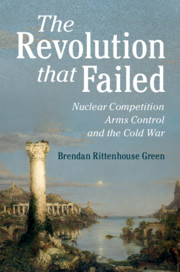Book contents
- The Revolution that Failed
- The Revolution that Failed
- Copyright page
- Dedication
- Epigraph
- Contents
- Figures and Tables
- Acknowledgments
- Introduction
- 1 The Nuclear Revolution Revisited
- 2 The Delicacy of the Nuclear Balance
- 3 Comparative Constitutional Fitness
- 4 Testing the Argument against Its Competitors
- 5 Nixon and the Origins of Renewed Nuclear Competition, 1969–1971
- 6 Nixon, Ford, and Accelerating Nuclear Competition, 1971–1976
- 7 The Rise of Nuclear Warfighting, 1972–1976
- 8 Carter and the Climax of the Arms Race, 1977–1979
- 9 The Revolution that Failed
- Index
7 - The Rise of Nuclear Warfighting, 1972–1976
Published online by Cambridge University Press: 26 February 2020
- The Revolution that Failed
- The Revolution that Failed
- Copyright page
- Dedication
- Epigraph
- Contents
- Figures and Tables
- Acknowledgments
- Introduction
- 1 The Nuclear Revolution Revisited
- 2 The Delicacy of the Nuclear Balance
- 3 Comparative Constitutional Fitness
- 4 Testing the Argument against Its Competitors
- 5 Nixon and the Origins of Renewed Nuclear Competition, 1969–1971
- 6 Nixon, Ford, and Accelerating Nuclear Competition, 1971–1976
- 7 The Rise of Nuclear Warfighting, 1972–1976
- 8 Carter and the Climax of the Arms Race, 1977–1979
- 9 The Revolution that Failed
- Index
Summary
A number of key puzzles from the era of détente remain unresolved. A particularly salient aspect of nuclear policy during the 1970s was the debate over limited nuclear options (LNOs): how central should LNOs be to nuclear doctrine and what form should they take? Moreover, at the same time these questions were being resolved, arms control took a bizarre turn. A negotiation that had centered on ballistic missiles and their counterforce capability suddenly came to focus on cruise missiles – slow moving second-strike weapons of less than intercontinental range. The conjunction of these two issues was not coincidental. Theater range cruise missiles and LNOs suggested the possibility of less than all-out nuclear exchanges, potentially occurring over a protracted period of time. They also coincided with intelligence suggesting Moscow was thinking about nuclear war in such terms. How should Washington have responded to these new circumstances?
- Type
- Chapter
- Information
- The Revolution that FailedNuclear Competition, Arms Control, and the Cold War, pp. 156 - 189Publisher: Cambridge University PressPrint publication year: 2020



